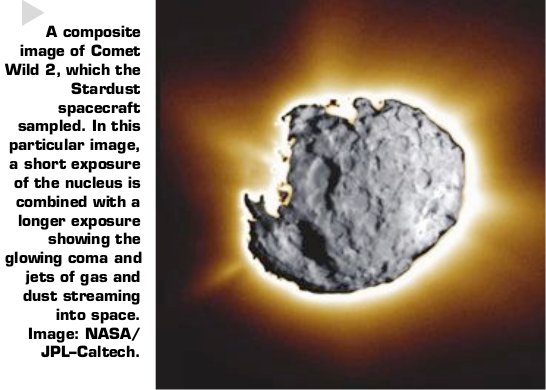Comets - What?
- Introduction
- Comets
- Asteroids
- Meteorites
- Meteor Showers
- Rock Types
- Identification
- Origins
- Destruction
Click here for the PDF Download of this booklet
Next Chapter: Comets - Where and When?
Comets are constructed from primordial material generated during the dawn of the Solar System around 4.6 billion years ago. Comets are the detritus from the planet-forming period and give insights into that distant time. They were forged before the Sun’s heat or collisions with other bodies could alter them chemically and as such they preserve the pristine material of the infant Solar System in their composition. If we can understand the materials inside comets we can understand what the building blocks were that formed the planets in our Solar System.
Comets all differ in their composition and in the relative amount of ices to dust particles within them. Besides water-ice, astronomers have detected in comets the likes of carbon monoxide, carbon dioxide, methane, ethane, ammonia, formaldehyde, ethanol, hydrogen cyanide, and even amino acids.
Many of these aforementioned constituents are similar to the pre-biotic material believed to have been present on the very early Earth. Astrobiologists agree that these compounds are the prerequisites in order for life to develop. The nuclei of comets are coated in these organic compounds, in the form of a thick dark crust of organic tar, underneath which lies ice. One idea promoted by some scientists at the Cardiff Centre for Astrobiology is that as a comet nears the Sun, the ice beneath the crust melts, forming reservoirs that could act as havens for micro-organisms. Comets crashing into the young Earth may have therefore delivered life to our planet, a theory called 'panspermia'.
It is the dark, organic crust of a comet that enables it to burst into life as it approaches the Sun, soaking up heat that bakes off the volatile gases on the surface causing outgassing. A gaseous cloud develops around the nucleus, and the solar wind sculpts this coma into a majestic tail, sometimes millions of kilometres long. The tail generally points away from the Sun, but if long enough it can appear to curve as the comet follows its orbit. A second tail, the ion tail, does point in exactly the opposite direction to the Sun and the solar wind. The ion tail is fainter, and is created when ultraviolet radiation from the Sun acts on the gaseous particles in the comet’s coma.

Many comets have a density less than that of water, which perhaps gives some indication that they are not quite as solid as they might appear from the outside. As such, their porous structure can break up and fragment rather easily. Many asteroids are also loosely held together ‘rubble piles’. It is believed that many asteroids are therefore fragments of larger bodies which have been broken up through collisions, however comets did not form in the same way. If a comet had been formed through a collision, the heat created would have driven off all it's ices that can be seen through observations. Thus we know that comets must have formed in a much more gentle environment than that in which asteroids did.
Next Chapter: Comets - Where and When?


